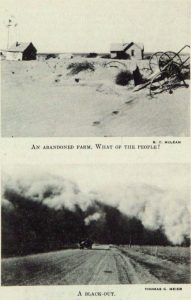The 1970s are generally thought of as the era when the conservation movement took hold in Colorado, but as a number of documents in our library demonstrate, it had its roots back to the early 1900s, when schoolchildren planted trees on “Arbor Day” — the precursor to today’s Earth Day. By 1940, the movement for conservation of natural resources had expanded, as you can read about in Colorado’s Wealth: A Bulletin on Conservation of Natural Resources. This 136-page booklet was issued by the Colorado Department of Education in an effort to teach youngsters about the importance of conserving the state’s natural resources which, in many places around the state, had been decimated by mining, dryland farming, and other industry in the late nineteenth and early twentieth centuries.

The conservation movement was not only in Colorado, but nationwide, though prevalent in the Western states. National Parks were being established at a rapid rate after the passage of the Antiquities Act of 1906, and in the 1930s one of the work programs of the Great Depression had been the Civilian Conservation Corps (CCC), where young men were given jobs planting trees, fighting forest fires, teaching citizens about soil conservation (important during the Dust Bowl), conserving and reintroducing fish and wildlife species, and establishing parks by breaking trails and building roads and public buildings to be used by citizens for the appreciation of natural resources.
Schoolteachers used the Colorado Department of Education booklet, issued during the same era as the CCC, to help children appreciate and protect Colorado’s natural wonders. The booklet starts off with a quote from Walter Lowdermilk of the U.S. Soil Conservation Service, entitled “The Eleventh Commandment:” “Thou shalt inherit the holy earth as a faithful steward, conserving its resources and productivity from generation to generation…if any shall fail in this stewardship…thy descendants shall decrease and live in poverty or perish from off the face of this earth.” The booklet continues with a discussion of the conservation movement and a “challenge to schools” from Charles Lory, former president of Colorado A&M (later Colorado State) University. The remainder includes essays on various conservation topics to give teachers “an understanding of land problems and the effects of the misuse of land resources on the entire population of our country” in the 1930s and 1940s. Concepts such as erosion are shown in drawings while photos of flood damage and dust storms graphically illustrate what can happen when conservation is ignored. The final part of the book illustrates projects that children and youth have created or participated in as ideas of how to get them involved in the conservation movement. Some of the projects discussed show a diversity in the students creating them — projects from Navajo and “Spanish-American” students are included.
This publication is a fascinating look at the conservation movement during an era when the past several generations’ overuse of the land caused widespread ramifications and in response inspired a new appreciation of the state’s soil, botany, and wildlife.
- How to Spot the Differences Between Eagles and Hawks - August 16, 2021
- How Transportation Projects Help Tell the Story of Colorado’s Past - August 9, 2021
- Time Machine Tuesday: The Night the Castlewood Canyon Dam Gave Way - August 3, 2021